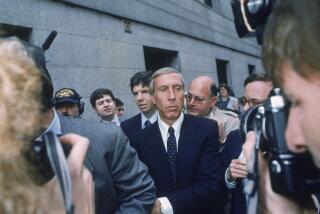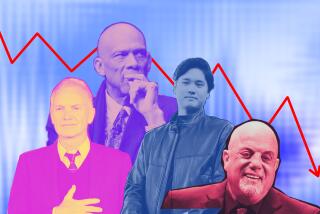Money Manager Still Picking Up the Post-Crash Pieces
WOODLAND HILLS — The stock market crash in October, 1987, was a nightmare for many investors. Unfortunately for David H. Menashe, an investor, money manager and publisher of an investment newsletter, the fright isn’t quite over yet.
During the crash, he watched $100,000 of his wealth evaporate. He also lost $60,000 of the $300,000 that three clients gave him to invest shortly before the crash. And although the market has regained all of the ground that it lost in the crash, many small investors still have the jitters, and that isn’t good news for somebody like Menashe.
His personal money-management business, Menashe said, is flat. “I haven’t had any new clients since last year.”
And since the crash, more than half of the 1,200 people who had been buying his newsletter, Fund-line, have dropped their subscriptions. The annual subscription before the crash cost $97 and is now $127, so Menashe has lost about $67,000 a year in newsletter sales.
Being tied to the market guarantees ups and downs for a small business like Menashe’s, where he’s the only employee. What does he do now? Be calm, wait until investors feel better about the market, then advertise heavily and hope new clients come knocking.
Menashe has been offering market tips for 20 years and claims to have made enough correct calls to have carved out a rather wealthy living--even if he is not a household name who’s regularly quoted in the financial press.
Not Desperate Yet
Given his net worth, which he says is well into six figures, and given his age, 67, Menashe isn’t desperate to sign up new customers.
“When I feel confident that the confidence is out there again, then I’ll promote again. I’ll do some advertising, some direct mail,” he said.
Menashe, who raised chickens before he got into the stock-picking business, manages about $3 million in other people’s money for investment mostly in mutual funds, and he collects a fee of 1.5% of his clients’ assets at the end of the year. His newsletter focuses only on trying to pick winners among stock mutual funds, rather than individual stocks.
Why? When Menashe started his business in 1968, mutual funds were a hot item with investors, who liked the idea of pooling their money to own a variety of stocks. But mutual funds can drop like any investment, and Menashe said he started the newsletter “with the idea that I would be smart enough to tell them when to get out and to warn them of the pitfalls.”
He contends that over the last 2 decades, an investor would have earned an average 16% total return on an investment each year from following his advice. “Which is not as good as I’d like,” he said. “Some years I’ve gone 25%, 27%. Other years I’ve done less.”
Average Track Record
According to an impartial source, Menashe’s forecasting track record appears only about average in recent years. The Hulbert Financial Digest in Alexandria, Va., which monitors the performance of newsletters’ stock picks, said Menashe’s Fundline gained 29.3% from the start of 1986 until the end of 1988. That left Fundline near the bottom among mutual-fund newsletters; 11 others did better, and four did worse. Among all 77 stock newsletters tracked by Hulbert, Fundline came in 31st.
In any case, Menashe’s Fundline isn’t the only investment newsletter whose following has dwindled in recent months. Norman G. Fosback, an oft-quoted Fort Lauderdale, Fla., publisher of several newsletters, including one on mutual funds that has 175,000 subscribers, said “renewal rates for all mutual fund newsletters are down.”
“In our case, 65% used to renew, now it’s about 40% or 50%,” Fosback said. “The bottom line is there is very little interest in funds right now.”
Menashe, Fosback and other advisers often count on advertising to help bolster circulation. Menashe has advertised in Barron’s, Money and other financial publications, and has used direct-mail ad campaigns. But advertising is costly--it can account for half of Menashe’s total expenses--and these days not enough investors are responding to the ads to make the cost worthwhile.
Menashe said that a year ago he spent $5,000 to send ads directly to 20,000 people on a mailing list of current and past subscribers that he had collected over 2 decades. “The return was very poor,” he said. He picked up fewer than 20 subscribers.
In 1987, Menashe’s gross income from the newsletter and his money-management service was about $108,000. His costs that year were $12,800 for advertising, $8,500 for printing, $5,600 for postage and $1,100 in telephone charges. His pretax income was about $80,000.
Last year, however, he did not advertise because he feared that new subscriptions would not cover the costs. Meanwhile, more subscribers dropped Menashe’s newsletter, leaving him with much less income in 1988, he said.
Chicken Business
Menashe was born in Brooklyn, N.Y., but that is as close as he ever got to Wall Street. When he was 10, his parents moved the family to Burbank, where his father started a chicken ranch. The younger Menashe, after flying several B-25 bombing missions in the Pacific during World War II, then started his own chicken business, first in Sepulveda and then in Moorpark.
Although his chicken flock grew to 30,000 from 4,000, Menashe had some money in the stock market and decided in 1959 to become an investment adviser. But after 4 years of “so-so success,” he went back to chicken ranching for another 5 years.
By 1968, however, Menashe decided that the only way to make good money in chickens was to raise hundreds of thousands of chickens--a growth plan he was unwilling to pursue. Menashe decided to give the stock market another try.
With about $20,000, he opened an office in Woodland Hills and started publishing his newsletter. He later moved his office into his house. He based his recommendations on the market’s “technical” trends.
Generally speaking, technical analysts believe that the stock market moves in repeating cycles and that money can be made if investors correctly buy or sell at certain points within those cycles. Technical analysts pay little heed to corporate profits or the economy’s overall direction.
Menashe insisted that technical market trends “will show up before the fundamental news will show up,” so that “you know there’s trouble up ahead.”
Menashe’s newsletter typically is eight pages; the first two are filled with his advice, and the rest contain several technical charts and graphs, including some devoted to individual mutual funds. On the back page, Menashe lists the recent track record of 40 or so funds and tells readers which funds to buy, sell, hold or ignore.
Best, Worst Calls
Menashe said his best call came in January, 1973, when he urged subscribers to sell every mutual fund share they owned. Soon thereafter came the 1973-74 bear market. His worst call was in September, 1987, a month before the crash, when the market was dropping rather sharply from its record highs reached in August, 1987. Menashe counseled his subscribers that “yes, there has been a correction, but no, it’s not yet the beginning of a major bear market.”
Menashe urged his readers to be fully invested in stock funds.
Today, Menashe has about half of his money in real estate partnerships and the other half in--no surprise--stock mutual funds. He won’t diversify into bonds or gold. “That implies that you don’t have confidence in what the market’s going to do,” he said.
And just what is the market going to do? Menashe said he thinks that the market will probably advance over the next few months. So far this year, the Dow Jones average of 30 industrials is up 7.5%, but he warns that this year could be a repeat of 1961, when stocks rose sharply for the first few months, then sagged during the next 18 months.
“I’m generally confident, but I’m always looking out in case things change,” he said.
More to Read
Inside the business of entertainment
The Wide Shot brings you news, analysis and insights on everything from streaming wars to production — and what it all means for the future.
You may occasionally receive promotional content from the Los Angeles Times.











